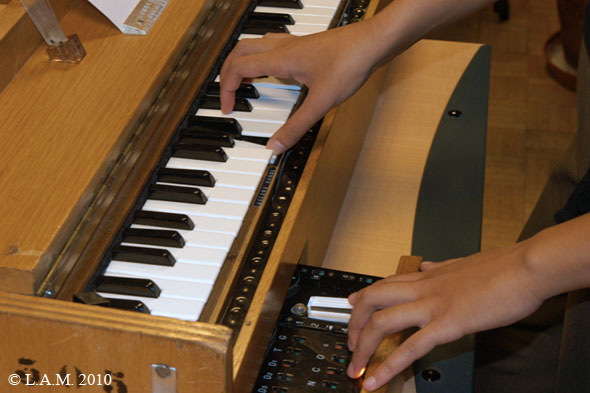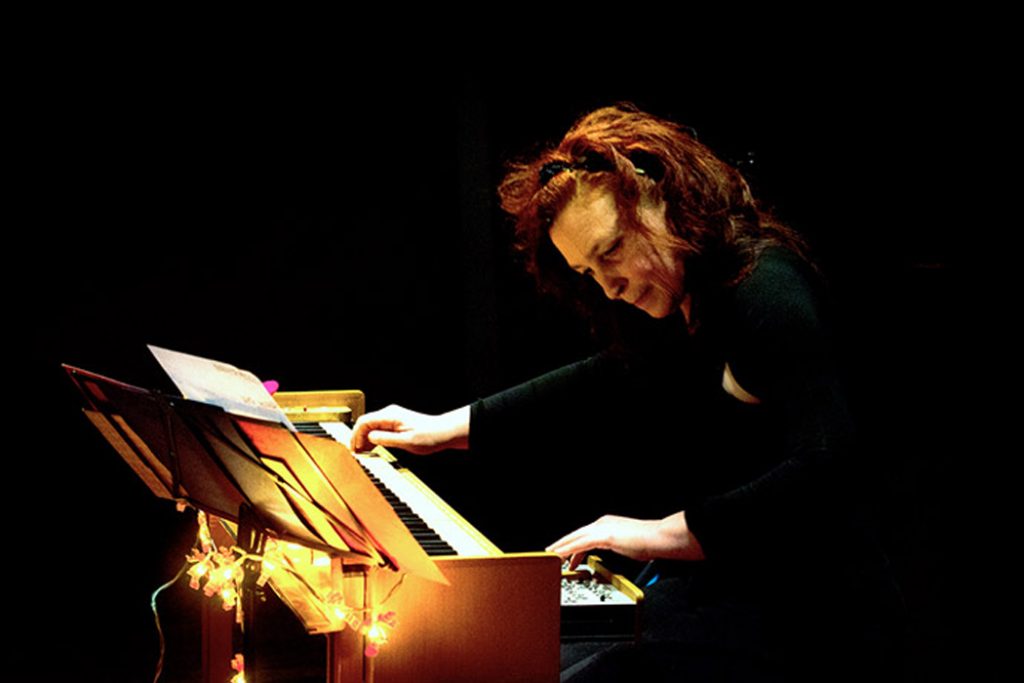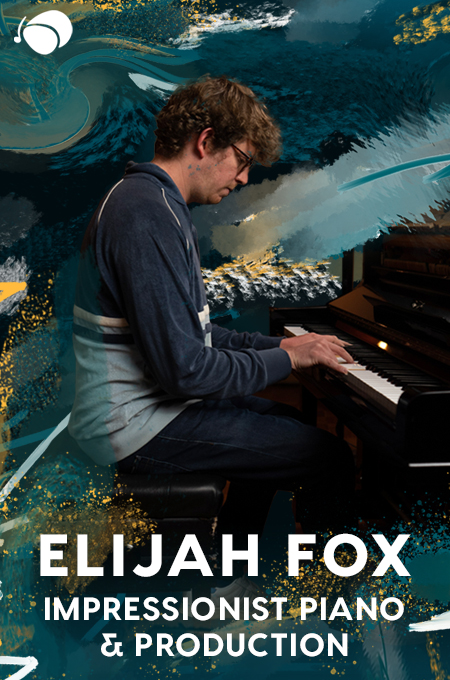+ Soundfly’s Intro to Scoring for Film & TV is a full-throttle plunge into the compositional practices and techniques used throughout the industry, and your guide for breaking into it. Preview for free today!
By Christine Ott
The Ondes Martenot is an instrument that was invented in 1928 by the French instrument-builder and cellist, Maurice Martenot. Using the same electronic technology as a theremin, it’s often considered one of the earliest analog synthesizers.
It’s monophonic just like the theremin, but unlike a theremin, the Ondes Martenot is played either by a keyboard or by moving a ring along a wire. Its expressiveness and pitch was designed to be reminiscent of the cello.

Contemporary French composer and multi-instrumentalist Christine Ott is one of very few master ondists out there today. As an artist with a drive to bridge the gap between the worlds of pop and classical music — who strives to bring down the walls separating the grandiosity of the concert hall and the intimacy of the living room — she makes use of the subtle sound effects of the Ondes alongside its expressive, lilting beauty.
So we asked Christine to share with us, a selection of her 7 favorite works for the Ondes Martenot, to help us explore this fascinating instrument up close, and she did not disappoint. Read on to see what she chose!
1. André Jolivet – “Suite Delphique”
I chose to begin our musical journey with a key work in the repertoire for Ondes Martenot; André Jolivet’s “Delphic Suite (for chamber orchestra and Ondes Martenot),” composed in 1943, premiered in 1948. Originally, it was the stage music for “Iphigénie à Delphes,” written by Gerhart Hauptmann. The structure of the piece involves eight movements, each with evocative titles like “Magical Aurora,” “The Dogs of the Erèbe,” and “Nature’s Rest.”
Jolivet was a student of both Paul Le Flem and Edgard Varèse, two masters with very different approaches and personalities. Yet in a complementary way, they gave Jolivet’s musical language a richness and openness, one that falls between primitivism and sophistication, complexity and simplicity, daring and tradition.
In the “Delphic Suite,” I really like the mixture of the chamber orchestra’s timbres, the dynamism, and the vital energy present in certain passages. There are often examples of early “sound effects” or “sound design” — well before its time — especially with the use of the Ondes Martenot, but always supporting the musical writing. As a composer myself, I often feel close to this kind of duality: between material and melody, between tradition and experimentation.
Of the teaching of his master, Edgard Varèse, Jolivet later wrote:
“Before Varèse, I wrote with notes. After Varèse, I composed with sounds.”
2. Marie Bernard – “8 Haïkus: No 2, L’échappée du temps”
Here is a much more recent work. Released in 2019, it was written by Canadian ondist, Marie Bernard. It’s a very beautiful and organic work, slightly “wild and ethnic” in terms of how it utilizes rhythms, dynamics, and percussiveness as the choir plays with onomatopoeias.
As for the Ondes Martenot’s role, the playing here is virtuosic and energetic; making use of a technique called “percuté” (mimicking the attack of certain percussion instruments, whereby the attack of the note becomes almost more important than the pitch).
The Ondes Martenot features a subtle yet vital “touch of expression” (almost like the role of the bowing techniques in stringed instruments) which will give the playing its nuance, intensity, phrasing, percussiveness, etc. You can find “la touche d’expression” in a small drawer and it reacts under our index finger of the left hand. The index finger of the right hand is slipped into a ring (“la bague”), which is connected on both sides to a ribbon. It allows a continuous sound, with glissando and microtones.

But you can also play the keyboard with the right hand. This requires great independence of the hands; the agile right hand running across the keyboard, while the responsive left hand sculpts the sound using the expression key. The keyboard allows for note specificity, and yet the timbre can be elevated into suspension with vibrato and natural sounding overtones.
3. Roger Tessier – “Hexade”
For a more contemporary piece, I could have chosen “Les courants de l’espace” by Tristan Murail, but I am happy to share a lesser-known piece by one of his colleagues — “Hexade” by Roger Tessier, composed for six Ondes Martenot.
In 1971, Roger Tessier met Tristan Murail, with whom he co-founded the ensemble L’Itineraire. Tessier’s music reflects his rich and eclectic career, mixing traditional instrumentation and electronic violins, energetic tracks and meditative passages, references to visual arts and literature.
It is an astonishing and powerful piece. The opening is quite remarkable, with a very interesting work on the bass and timbres but also on the “crunches,” or “craquements,” a specific term that one uses for the Ondes Martenot. It’s easy to see that Tessier knows the instrument well to use this powerful and particular effect, at one point considered to be a fault with the instrument.
Side note: Some factions inside the ondist community wanted to remove the possibility of this effect by correcting the design flaw that causes it, but they were met with an uproar by those (including me) who realized its importance in performing the modern repertoire of the Ondes Martenot. In the end, the consultations resulted in not making the proposed modifications.
4. Danny Elfman – Mars Attacks! (Original Motion Picture Soundtrack)
With this film score, it’s a little more anecdotal, less central, but I like when the Ondes gets used creatively in this kind of orchestration. Usually, I don’t really like when you associate the Ondes and theremin with ghosts and aliens, but it must be said that it is extremely tempting, and sometimes can be quite successful.
I did try to seek out a film score where the Ondes is more central. With regards to personal works I have played on, I could have chosen Bastards by Claire Denis (with music by Tindersticks), or Manta Ray by Phuttiphong Aroonpheng (with music by Snowdrops). And I could also have talked about lots of older films from the ’30s and ’40s, but hey… in the end, let’s go for the aliens!
Mars Attacks! is a very funny film by Tim Burton, with a wonderfully funny score by Danny Elfman. The musical writing is at once both grandiose and sarcastic — another duality that works well in scoring or orchestration in general. And this is aided by the playing of Jeanne Loriod on the Ondes Martenot, which emphasizes the ribbon playing techniques at a high level. For me, no one has been able to make the Ondes sing as beautifully, with intensity and musical expression always at the service of an incredible musicality, as Loriod.
I was lucky to have her as a professor at the Paris Conservatory, but above all to continue working with her after my studies. I owe her a lot, and Elfman’s music here fits her like a glove. Their partnership on this score gives an incomparable color to the film.
5. Radiohead – “How to Disappear Completely”
It is sometimes a problem to lock the Ondes Martenot and its repertoire in a very tight box — thus, it is impossible to talk about the Ondes without talking about Olivier Messiaen or Radiohead’s Jonny Greenwood. These two essential names have done a lot to bring this instrument into the public conversation, but many times, people’s curiosity stops here.
It’s a bit of a shame… But it’s also somewhat inevitable, considering the rarity of the instrument and its difficulty to perform or transport; the extended apparatus including four loudspeakers and a diffuser. And yet, the Ondes Martenot has been around for nearly a century, and sometimes I have the impression that a great deal of knowledge is doomed to disappear. Jean-Loup Dierstein, who has studied the Ondes for a long time and who currently builds these instruments by making modifications to the original schematic, has no current successor. The transmission and legacy of this knowledge may soon be lost forever.
Jonny Greenwood and Radiohead have undoubtedly helped the fashionable return of this instrument though, and I love the work that they’ve done to restore it. “How to Disappear Completely” is an incredible track that does just that. It was envisioned, composed, and even produced to highlight the characteristics and subtleties of the Ondes Martenot, intertwined with strings and accompanying the bewitching voice of Thom Yorke.
Here is a very special version, filmed for Canal+, which features six ondists, including Greenwood (and including myself!), sitting around Yorke. It was a very special moment, and very strong emotionally.
The Ondes Martenot is a monophonic instrument, so it only produces one note at a time, when composers or arrangers work with several players, you can achieve a polyphony and harmony. The result is always a beautiful and ethereal sound, due to the overtones and microtonalities that this instrument produces.
6. Jean-Philippe Goude – “L’Homme dévasté”
I esteem and I greatly admire the writing and the music of Jean-Philippe Goude, in general, and specifically for the Ondes Martenot. “L’Homme dévasté” is a piece for a small ensemble, Ondes Martenot and electronics, and I actually performed it on stage at the Théâtre National de Bretagne in 2008.
The Ondes Martenot part is a bit crazy, extremely lively, and virtuosic in certain places. Certain very lyrical passages transform the instrument into a real “opera diva;” and others are technically quite difficult, featuring terribly long intervals on the ribbon. Of my past collaborations, it is one of the pieces that I like to perform the most but also to listen to again and again.
7. Roly Porter – “Tleilax”
For my final choice I wanted to feature an electronic piece, and nothing suits better than Roly Porter’s “Tleilax,” with none other than Cynthia Millar on the Ondes Martenot.
I’m not sure what I love more, the loop of the Ondes from which the entire piece is built, or the entire universe of sounds that surround it. It’s almost as if, after an atomic bomb explosion, there were only a few organic sounds and bits left, and Porter’s work makes use of them all!
Have you checked out Soundfly’s courses yet?
Continue your learning with hundreds of lessons by boundary-pushing, independent artists like Kimbra, Ryan Lott & Ian Chang (of Son Lux), Jlin, Elijah Fox, Kiefer, Com Truise, The Pocket Queen, and RJD2. And don’t forget to try out our intro course on Scoring for Film & TV.
—
Christine Ott’s latest album, Chimères (pour ondes Martenot), is out now via Nahal Recordings.





